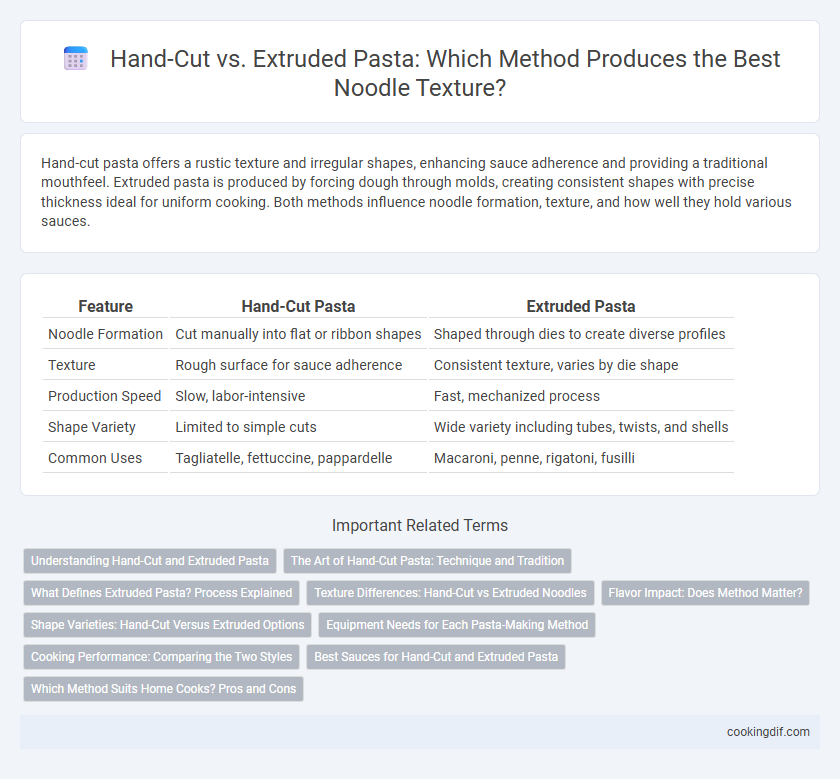Hand-cut pasta offers a rustic texture and irregular shapes, enhancing sauce adherence and providing a traditional mouthfeel. Extruded pasta is produced by forcing dough through molds, creating consistent shapes with precise thickness ideal for uniform cooking. Both methods influence noodle formation, texture, and how well they hold various sauces.
Table of Comparison
| Feature | Hand-Cut Pasta | Extruded Pasta |
|---|---|---|
| Noodle Formation | Cut manually into flat or ribbon shapes | Shaped through dies to create diverse profiles |
| Texture | Rough surface for sauce adherence | Consistent texture, varies by die shape |
| Production Speed | Slow, labor-intensive | Fast, mechanized process |
| Shape Variety | Limited to simple cuts | Wide variety including tubes, twists, and shells |
| Common Uses | Tagliatelle, fettuccine, pappardelle | Macaroni, penne, rigatoni, fusilli |
Understanding Hand-Cut and Extruded Pasta
Hand-cut pasta features irregular edges and varying thickness, offering a rustic texture that holds sauces well, ideal for traditional dishes like pappardelle. Extruded pasta is shaped by forcing dough through dies, creating uniform shapes such as penne and rigatoni, optimized for consistent cooking and sauce adherence. Understanding these differences helps in selecting the right pasta for texture, presentation, and sauce compatibility in culinary applications.
The Art of Hand-Cut Pasta: Technique and Tradition
Hand-cut pasta embodies centuries-old Italian tradition, where dough is skillfully rolled and sliced by hand to create shapes like pappardelle and tagliatelle with artisanal texture and uneven edges that hold sauces better. Unlike extruded pasta, which pushes dough through dies to form uniform shapes such as penne or rigatoni, hand-cut pasta preserves a unique rustic quality and tactile appeal valued in regional dishes. Mastery of hand-cut techniques requires precision and experience, highlighting pasta-making as both craft and cultural heritage.
What Defines Extruded Pasta? Process Explained
Extruded pasta is defined by its production method, where dough is forced through bronze or Teflon-coated dies under pressure, creating shapes with a consistent texture and firm bite. This process allows for intricate designs like penne or rigatoni, which are difficult to achieve with hand-cut methods. The extrusion technique also enhances sauce adherence due to the pasta's slightly rough surface, improving the overall flavor experience.
Texture Differences: Hand-Cut vs Extruded Noodles
Hand-cut pasta features irregular thickness and rough edges that enhance sauce absorption and deliver a rustic texture, while extruded pasta offers uniform shapes with smoother surfaces, creating a firmer and more consistent bite. The porous quality of hand-cut noodles contrasts with the denser, more compact structure of extruded varieties, impacting mouthfeel and cooking behavior. Texture differences influence culinary applications, with hand-cut noodles preferred for hearty sauces and extruded pasta ideal for lighter, more delicate preparations.
Flavor Impact: Does Method Matter?
Hand-cut pasta often delivers a denser texture that enhances sauce retention and intensifies flavor absorption, creating a more rustic and artisanal bite. Extruded pasta, produced by forcing dough through shaped dies, offers uniformity and a slightly porous surface that effectively clings to thicker sauces, subtly influencing the overall taste experience. The method of noodle formation impacts flavor perception by altering surface texture and sauce adherence, making the choice between hand-cut and extruded pasta significant for culinary outcomes.
Shape Varieties: Hand-Cut Versus Extruded Options
Hand-cut pasta offers irregular shapes and varied thicknesses, giving each piece a unique texture that holds sauce differently. Extruded pasta, produced by forcing dough through specific molds, results in precise, uniform shapes such as rigatoni, penne, and fusilli, ideal for consistent cooking. Shape variety in extruded pasta supports specific sauce pairings, while hand-cut noodles provide artisanal appeal and texture diversity.
Equipment Needs for Each Pasta-Making Method
Hand-cut pasta requires minimal equipment, typically a rolling pin and a sharp knife or pasta cutter, promoting artisanal texture and shape variety. Extruded pasta demands specialized machinery like pasta extruders with interchangeable dies to shape dough under pressure, enabling consistent forms such as penne or fusilli. The choice between methods impacts production scale, with hand-cut ideal for small batches and extruded suitable for large-scale manufacturing.
Cooking Performance: Comparing the Two Styles
Hand-cut pasta offers a porous texture that absorbs sauce more effectively, enhancing flavor retention during cooking. Extruded pasta, shaped by pressing dough through dies, has a denser consistency that provides firm bite and uniform cooking times. Both styles respond well to boiling, but hand-cut varieties may require gentler handling to prevent sticking or tearing.
Best Sauces for Hand-Cut and Extruded Pasta
Hand-cut pasta, with its rougher texture and irregular shapes, excels at holding onto chunky and creamy sauces like ragu, pesto, or Alfredo, enhancing the overall flavor in each bite. Extruded pasta, characterized by its smooth and uniform surfaces, pairs best with lighter, oil-based sauces such as aglio e olio or seafood sauces that cling well to the pasta's grooves and hollow shapes like penne or rigatoni. Matching the pasta type with the appropriate sauce texture ensures optimal absorption and taste balance in Italian cuisine.
Which Method Suits Home Cooks? Pros and Cons
Hand-cut pasta offers home cooks greater control over thickness and shape, producing a rustic texture ideal for simple sauces, but it demands more time and skill, making it less efficient for beginners. Extruded pasta results in consistent shapes and textures through a mechanical process, perfect for replicating traditional varieties like penne or rigatoni with less effort, but it lacks the artisanal feel and may require specialized equipment. Home cooks seeking customization and a hands-on experience often prefer hand-cut methods, whereas those prioritizing convenience and uniformity benefit from extruded pasta tools.
Hand-cut vs Extruded pasta for noodle formation Infographic

 cookingdif.com
cookingdif.com